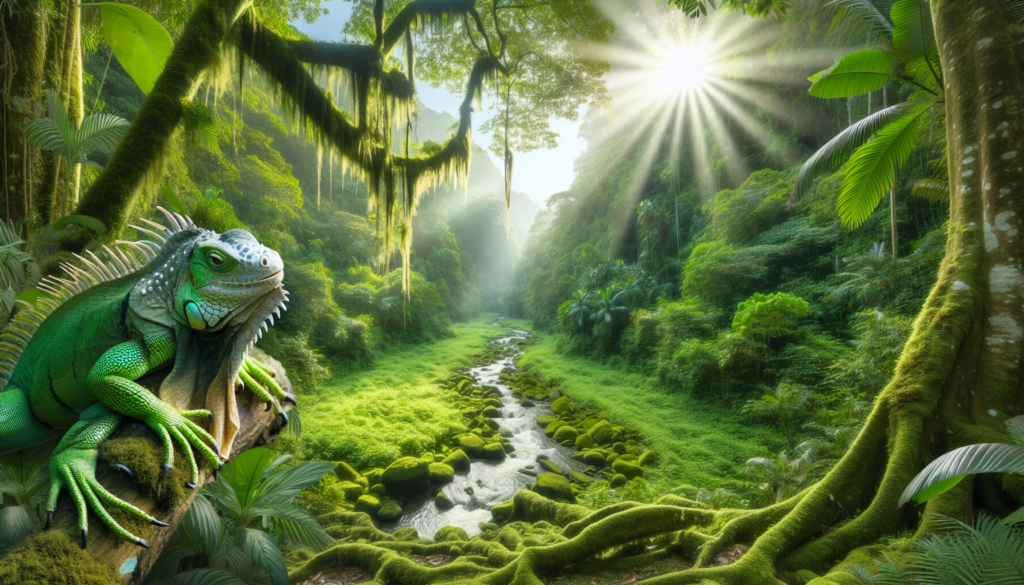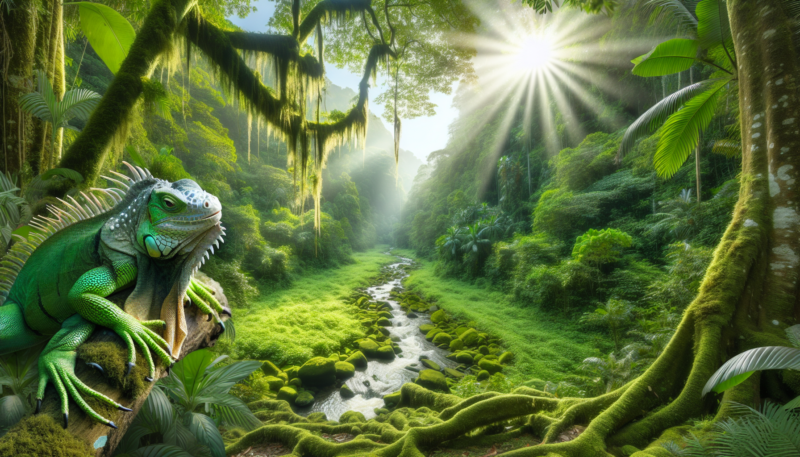Are you fascinated by the vibrant and mesmerizing green iguanas? If so, you’re in for a treat! In this article, we will take you on a captivating journey, exploring the perfect habitat for these magnificent creatures. From lush tropical forests to vibrant coastal regions, we will unveil the secrets of what makes the ideal green iguana habitat. So grab your binoculars and get ready to embark on an adventure like no other!

Key Aspects of Green Iguana Habitat
Green iguanas are beautiful reptiles that require a specific set of conditions to thrive in captivity. To ensure their well-being, it is crucial to create an ideal habitat that mirrors their natural environment. In this comprehensive article, we will explore the key aspects of a green iguana’s habitat, covering everything from climatic conditions to managing iguana stress. By following these guidelines, you can provide a comfortable and stimulating home for your green iguana.
Climatic Conditions
Green iguanas are native to the tropical rainforests of Central and South America. Thus, they require a warm and humid environment in captivity. Maintaining the correct climate is vital for their overall health and well-being.
Temperature Range
Green iguanas are ectothermic, which means they rely on external heat sources to regulate their body temperature. The temperature gradient within their enclosure is essential for their thermoregulation. Provide a basking spot with a temperature of 95-105°F (35-40°C) at one end of the enclosure, while keeping the ambient temperature around 80-85°F (27-29°C). At night, the temperature can drop slightly to around 75-80°F (24-27°C).
Humidity Levels
Green iguanas thrive in high humidity levels. Aim to maintain a humidity level of 70-80% within their enclosure. This can be achieved by misting the enclosure with water and using a reptile fogger or humidifier. Ensure there is adequate ventilation to prevent excessive moisture buildup, which can lead to respiratory issues.
Habitat Size and Enclosure
Providing an adequately sized enclosure is crucial for the well-being of your green iguana. Their habitat should offer enough space for them to move around freely, climb, and exhibit natural behaviors.
Terrarium Size
A single adult green iguana requires a large enclosure measuring at least 6 feet (1.8 meters) long, 3 feet (0.9 meters) wide, and 6 feet (1.8 meters) tall. This allows them to stretch their legs and fully extend their bodies. Remember, the bigger the enclosure, the happier your green iguana will be.
Vertical Space
Green iguanas are fantastic climbers, so it is essential to provide ample vertical space within their enclosure. Incorporate branches, sturdy perches, and platforms at various heights to allow them to exercise their natural climbing abilities. This vertical space enables them to bask, explore, and feel secure in their environment.
Furnishings and Enrichment
Make your green iguana’s habitat more engaging by adding various decorations and enrichment items. Large rocks, logs, and artificial plants can create a more naturalistic environment and offer hiding spots for your iguana. Additionally, providing interactive toys and puzzles will stimulate their mind and prevent boredom.
Lighting and Heating Requirements
In their natural habitat, green iguanas bask in the sun, absorbing UVA and UVB rays to maintain their overall health. Adequate lighting and heating within their enclosure are critical for their physical and psychological well-being.
UVA and UVB Lighting
Green iguanas require access to both UVA and UVB lighting. UVA lighting promotes natural behavior and helps stimulate appetite, while UVB lighting is essential for the synthesis of vitamin D3, which aids in calcium absorption. Use a high-quality fluorescent UVB bulb specifically designed for reptiles and position it 12-18 inches (30-46 centimeters) away from your green iguana’s basking spot.
Basking Spots
Create a designated basking area in your green iguana’s enclosure. This spot should be positioned close to the UVB light source and maintain a temperature of 95-105°F (35-40°C). Use a flat rock or wooden platform as the basking spot, ensuring it is sturdy enough to support your iguana’s weight.
Heat Sources
In addition to the basking spot, provide supplemental heat sources to create a temperature gradient within the enclosure. This can be achieved using ceramic heat emitters or heat mats placed at one end of the enclosure. Use a thermostat to regulate the temperature and prevent overheating.
Feeding and Watering Zones
Green iguanas have specific dietary requirements and need access to fresh water for hydration. Designating specific areas for feeding and watering will help create a structured routine and prevent contamination.
Food Sources
green iguanas are herbivores, primarily feeding on a diet of leafy greens and vegetables. Offer a variety of greens, such as collard greens, mustard greens, and dandelion greens. Supplement their diet with vegetables like squash, bell peppers, and carrots. Avoid feeding them animal protein, as this can lead to metabolic issues.
Water Requirements
Place a shallow water dish within the enclosure to provide your green iguana with fresh water for hydration. Ensure the water is changed daily to maintain cleanliness. Additionally, consider misting the enclosure to provide additional moisture and encourage drinking.
Vegetation and Plants
Introducing live vegetation and plants into your green iguana’s habitat not only creates a naturalistic environment but also provides additional nutrients and enrichment opportunities. Choose non-toxic plants that are suitable for reptile enclosures, such as hibiscus, pothos, and spider plants.
Creating a Comfortable Environment
To ensure your green iguana feels secure and content, provide various hiding spots, climbing opportunities, and select the appropriate substrate.
Hideouts and Retreats
Green iguanas require hideouts and retreats in their enclosure to avoid feeling exposed. Use branches, logs, or commercial reptile hides to create hiding spots where they can retreat to when stressed or seeking solitude.
Climbing Opportunities
As natural climbers, green iguanas need plenty of opportunities to exercise their climbing skills. Incorporate branches, logs, and sturdy platforms at different heights within the enclosure. Ensure these structures are securely anchored to prevent any accidents.
Substrate Choices
Choose a substrate that is easy to clean, maintain humidity, and does not pose any health risks to your green iguana. Reptile carpet, newspaper, or paper towels can be used as suitable substrate options. Avoid using loose substrates like sand or wood chips, as they can be accidentally ingested and cause gastrointestinal issues.
Maintaining Proper Hygiene
Keeping your green iguana’s enclosure clean and hygienic is essential for their overall health. Regular cleaning and disinfection, as well as preventive measures against bacteria and parasites, are necessary.
Cleaning and Disinfection
Regularly clean the enclosure, removing any feces, uneaten food, or soiled substrate. Use a reptile-safe disinfectant to sanitize the enclosure and furnishings. Ensure the enclosure is completely dry before reintroducing your green iguana to prevent skin infections.
Preventing Bacterial Growth
Maintain optimal humidity levels and proper ventilation to prevent the growth of harmful bacteria. Monitor the enclosure for any signs of microbial growth, such as mold or foul odors, and promptly address any issues.
Eliminating Parasites
Parasites can pose a significant threat to your green iguana’s health. Consult with a reptile veterinarian to establish a regular parasite prevention program. Regular fecal examinations can help detect and treat any potential parasitic infections promptly.

Social Interaction and Stimulation
Green iguanas, like many reptiles, benefit from social interaction and mental stimulation. Providing opportunities for socialization, handling, and creating a stimulating environment can contribute to their overall well-being.
Importance of Socialization
Regular, gentle handling is crucial in acclimating green iguanas to human presence. Gradually introduce your iguana to handling sessions, ensuring they feel safe and comfortable. This helps reduce stress and develop a bond between you and your pet.
Handling and Taming
Handling should be done with care and caution, as green iguanas can become aggressive or stressed if mishandled. Support their body properly, avoiding any sudden movements or tight grips. Be patient and consistent, and always observe your iguana’s body language to ensure they are comfortable.
Creating a Stimulating Environment
Enrich your green iguana’s environment with various toys, puzzles, and climbing structures. Offer opportunities for exploration and mental stimulation by introducing new objects or rearranging the enclosure’s furnishings periodically. This encourages natural behaviors and prevents boredom.
Managing Iguana Stress
Stress can have adverse effects on the health and well-being of green iguanas. Minimizing environmental stressors, reducing human interference, and providing quiet zones are essential for keeping stress levels in check.
Reducing Environmental Stressors
Limit excessive noise, bright lights, and sudden movements in the vicinity of your green iguana’s enclosure. Establish a calm and quiet environment to create a stress-free space for your iguana. Avoid placing the enclosure in high-traffic areas to prevent unnecessary disturbances.
Minimizing Human Interference
While social interaction is beneficial, it is crucial to find a balance and respect your green iguana’s need for space. Avoid excessive handling, especially during periods of shedding or when they exhibit signs of stress. Observe your iguana from a distance, allowing them to feel secure in their environment.
Quiet Zones
Creating designated quiet zones within the enclosure can provide a safe haven for your green iguana to retreat to when they feel overwhelmed or stressed. Place hiding spots, foliage, or commercial iguana hides in these quiet zones to offer a sense of security.
Monitoring Health and Behavior
Regularly monitoring your green iguana’s health and behavior allows for early detection of potential issues. Understanding signs of illness, scheduling regular veterinary check-ups, and observing behavioral patterns are essential for maintaining their well-being.
Signs of Illness
Common signs of illness in green iguanas include loss of appetite, weight loss, lethargy, changes in bowel movements, respiratory distress, or abnormal skin coloring. Any noticeable changes in behavior or appearance should be evaluated by a reptile veterinarian promptly.
Regular Vet Check-ups
Schedule regular veterinary check-ups to ensure your green iguana is in good health. A reptile veterinarian can assess their overall condition, perform necessary tests, and provide guidance on any specific care requirements.
Behavioral Observations
Pay attention to your green iguana’s behavior and activity levels. Observe how they interact with their environment, their feeding patterns, and any changes in their overall demeanor. Identifying any deviations from their normal behavior can help catch potential health issues early on.
Special Considerations for Outdoor Habitats
While green iguanas are primarily kept as indoor pets, some enthusiasts may opt for outdoor enclosures. If you plan to create an outdoor habitat for your green iguana, consider the following factors for their safety and well-being.
Climate Adaptations
Ensure the outdoor habitat offers the necessary climate adaptations for your green iguana. Provide shade, shelter, and appropriate heating elements to protect them from extreme temperatures. Consider the local climate and make necessary adjustments to keep them comfortable.
Protection from Predators
Outdoor habitats pose a higher risk of predation compared to indoor enclosures. Implement measures to deter potential predators, such as secure fencing, predator-proof netting, and secure locking mechanisms for entrances. Regularly inspect the enclosure for any vulnerabilities.
Natural Vegetation and Landscaping
Utilize natural vegetation and landscaping to recreate a natural environment for your green iguana. Plant native species, create climbing structures, and incorporate hiding spots to provide a more engaging and enriching outdoor space for your iguana.
By focusing on these key aspects, you can create an ideal green iguana habitat that promotes their physical and psychological well-being. Remember to keep a close eye on their health, provide ample social interaction and stimulation, and adapt their environment to meet their specific needs. With proper care, your green iguana will thrive in their new habitat and bring you joy for many years to come.
